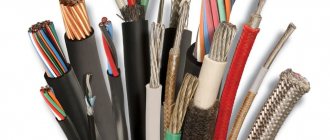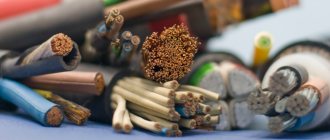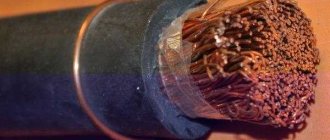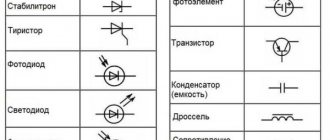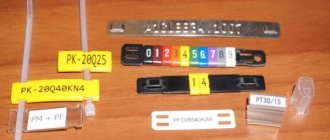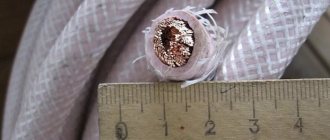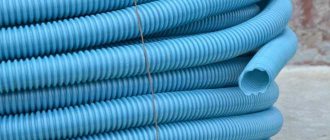Description and design of power cable VVGng-FRLS
Power cable VVGng-FRLS is a cable with copper conductors with insulation and a PVC sheath without protective coverings (armor). The letters “ng-FRLS” are added to the designation of the VVG cable brand if the insulation and sheath of the cable are made of plastic, which is fire-resistant and does not emit harmful substances.
Explanation of the designation:
- absence of the letter “A” at the beginning - copper conductors; — the first “B” — insulation made of PVC plastic, which is fire-resistant and does not emit harmful substances; — the second “B” is a shell made of PVC plastic, which is fire-resistant and does not emit harmful substances; - “G” - lack of armor (naked).
VVGng-FRLS cables can have from one to six cores with a cross-section from 1.5 mm2 to 240 mm2.
The range of core cross-sections depending on their number and operating voltage of the cable is shown in the table.
| Number of cores | Nominal cross-section, mm2 | |
| cable 0.66 kV | 1 kV cable | |
| 1,2,3,4 | 1,5 — 50 | 1,5 — 240 |
| 5,6 | 1,5 — 25 | 1,5 — 25 |
Two-core cables must have cores of the same cross-section. Three-, four- and five-core cables must have all conductors of the same cross-section or one conductor of a smaller cross-section (grounding or neutral conductor). Six-core cables must have four cores of equal cross-section and two wires of smaller cross-section.
The cross-sections of neutral conductors (in the case of a smaller cross-section than the main ones) and grounding conductors, depending on the cross-section of the main conductors up to 50 mm2, are given below.
| Main veins | 1,5 | 2,5 | 4 | 6 | 10 | 16 | 25 | 35 | 50 |
| Zero core | 1,5 | 1,5 | 2,5 | 4 | 6 | 10 | 16 | 16 | 25 |
| Grounding conductor | 1,0 | 1,5 | 2,5 | 2,5 | 4 | 6 | 10 | 16 | 16 |
The nominal and minimum values of insulation thickness for cables with a cross-section of up to 50 mm2 for operating voltages of 0.66 kV and 1 kV are given in the table. The upper limit deviation is not standardized.
| Cable voltage, kV | Nominal cross-section of cores, mm | Nominal insulation thickness, mm | Minimum insulation thickness, mm |
| 0,66 | 1 — 2,5 | 0,6 | 0,44 |
| 4 and 6 | 0,7 | 0,53 | |
| 10 and 16 | 0,9 | 0,71 | |
| 25 and 35 | 1,1 | 0,89 | |
| 50 | 1,3 | 1,07 | |
| 1 | 1-2,5 | 0,8 | 0,62 |
| 4-16 | 1,0 | 0,8 | |
| 25 and 35 | 1,2 | 0,98 | |
| 50 | 1,4 | 1,16 |
The thickness of the sheath of VVG cables depends on the twisting diameter of the insulated cores under the sheath. The nominal and minimum values of the shell thickness are given in the table. The upper limit deviation is not standardized
| Diameter under the shell, mm | Nominal insulation thickness, mm | Minimum insulation thickness, mm |
| Until 6 | 1,2 | 0,92 |
| 6 – 15 | 1,5 | 1,18 |
| 15 – 20 | 1,7 | 1,35 |
| 20 – 30 | 1,9 | 1,52 |
| 30 – 40 | 2,1 | 1,69 |
Design differences
The FRLS multifunctional cable is a kind of twisting of cores that are reliably isolated from each other. This material is made from high quality copper. Each core is placed in an outer sheath made of polyvinyl chloride for additional protection. The design provides for the presence of several powerful wires, which differ in cross-sectional area - from 1.5 to 10 square meters. mm. The main advantages of such a cable include the presence of a universal thermal barrier made of mica-containing material. This element performs the function of a dielectric.
An insulating layer of polyvinyl chloride is mounted on top of the thermal barrier. This design is characterized by a reduced level of flammability and the absence of smoke during combustion. The next ball is represented by modern waist insulation, which is made from durable PVC-based materials. At the final stage, an outer sheath is necessarily applied to the wire, which is presented in the form of fire-resistant plastic.
If there is an additional FRHF marking, then in addition to the usual fire resistance, the final halogen content in the smoke will be much lower than that of all other analogues. Thanks to this, you can reduce the negative impact on the environment in case of an unforeseen situation.
Conditions for installation and operation of the VVGng-FRLS power cable
The VVGng-FRLS cable is manufactured for use at industrial facilities and residential buildings, as well as for use at nuclear power plants (NPS), provided that it is laid outside the containment zone in AC electrical systems of class 2 according to OPB 88/97 classification (PNAE G - 01-011) Cables can be laid in structures with very high fire safety requirements, as well as in explosive zones of all classes, with the exception of class B-1 zones. The materials used in the sheath and insulation of the VVGng-FRLS cable are fire-resistant and do not emit harmful substances. As a result of using cables with the FRLS index, maximum conditions are provided to ensure the safety of people and equipment in the event of a fire.
The cables are designed for group installation and can withstand open fire. The cables are used for use in stationary installations. It is not recommended to use for laying in the ground.
The cables are intended for operation in ambient temperatures from +50°С to -50°С, relative air humidity up to 98% at temperatures up to 35°С.
Can be laid without preheating at a temperature not lower than -15°C. The minimum bending radius during installation must be at least 7.5 times the outer diameter of the cable
Purpose
The frls cable is designed for transmitting electricity in fixed lines using alternating voltage with a frequency of 50 Hz. These products are manufactured taking into account standard requirements for networks up to 660 V, as well as 1, 3 and 6 kV. Special standards determine the need to use such products when equipping medical institutions, industrial and public facilities. With their help, they increase the security of systems:
- notifications and alarms;
- fire extinguishing;
- smoke removal.
The main purpose is to provide favorable conditions for the rapid evacuation of people from a dangerous zone in the event of an emergency. The main control parameter is fire resistance. It determines the preservation of the functional state when exposed to an open flame. Smoke emission and the ability to support (spread) combustion are also regulated.
For your information. The set of special measures, in addition to the requirements for the technical characteristics of cable products, includes certain installation conditions. There are group and single versions with a permissible gap between conductive lines of up to and more than 30 cm.
Technical characteristics of power cable VVGng-FRLS
The conductors must be single-wire or multi-wire. Conductors up to 16 mm2 are made only single-wire, over 16 mm2 can also be multi-wire, i.e. twisted from individual wires (number of wires: at least 7 for sections 16, 25 and 35 mm2; at least 19 for sections 50, 70 and 95 mm2).
The conductors must be insulated and have a distinctive color. The insulation of the neutral conductors should be blue (light blue).
The insulation of the grounding conductors must be two-color (green-yellow).
The color marking must be continuous or in the form of a longitudinal stripe with a width of at least 1 mm. Digital marking of cores is also allowed.
Insulated cable cores must be twisted, the empty space between the twisted insulated cores must be filled with bundles or a mixture of insulating materials.
The sheath must be applied in such a way that it can be easily separated from the core insulation. To do this, a Mylar tape can be laid between the core insulation and the sheath. The shell color is predominantly black.
Cables with sector conductors can be manufactured without filling.
Two-core and three-core cables with cores with a cross-section of up to 16 mm2 inclusive can have insulated cores laid in the same plane - flat cables. In this case, the letter “P” is added to the designation of the VVGng-FRLS cable, separated by a hyphen: example: VVGng-FRLS-P.
It is allowed to twist insulated cable cores for voltages up to 1 kV inclusive, changing the direction of twisting.
Product advantages
Fire safety
. The cable does not burn either in a bundle or individually. It does not support combustion, does not spread fire, and retains its operating functions in case of fire for three hours.
Low smoke emission
. The material from which the external and internal insulation is made emits very little smoke when burned.
Reliability
. FRLS maintains its performance characteristics at significant temperature increases. It is designed for stable operation in a fire for three hours, thanks to which security and fire alarms continue to function in extreme conditions.
Moisture resistance
. Multi-layer insulation provides a high level of protection against water. The cable can be laid in wet areas, for example, with a swimming pool, bathroom, etc.
Mechanical strength
. The PVC plastic compound from which the insulation is made can withstand significant compression and bending loads without deforming or losing integrity. This allows the FRLS to be used in complex circuits that require twisting and bending.
Easy to use
. In a stranded wire, each core has its own color of the insulating layer, for example, the grounding is always yellow-green. This color designation greatly facilitates the use of the cable and simplifies its installation.
Requirements for marking power cable VVGng-FRLS
On the sheath no more than every 300 mm the distinctive index of the manufacturer and the year of manufacture of the cable must be applied. For cables with a diameter under the sheath of less than 20 mm, the use of colored marking thread is allowed.
The drum cheek or label attached to the coil or drum must indicate:
— trademark of the manufacturer; — symbol of the cable (full indicating the number of cores and cross-section); — cable length in meters and number of segments; — gross or net weight when delivered in coils in kilograms; — date of manufacture (year, month); — drum or coil number.
The label must bear a technical control stamp and a certification mark.
Selection rules
- Before purchasing, you must make sure that the product has a quality certificate. The document must contain basic information: safety class, throughput, performance characteristics.
- The selected FRLS cable must be suitable for its purpose and operating conditions. The total cross-section of the cores is designed to ensure the design throughput.
- It is very important that the insulation meets the required safety class. Therefore, you should only contact trusted suppliers. It is recommended that they have direct connections with manufacturing plants.
- Domestic products are not inferior to foreign cables in terms of performance properties, but have a lower cost. Replacing imported FRLS with Russian analogues does not deteriorate the quality of the wiring, but allows you to significantly save money.
To buy fire-resistant cables in the online store, fill out an application through the “Cart” or contact regional sales points. You can see current prices in our price list. For additional information, contact Unitest specialists: call them by phone or send a message in an online chat.
Weight and dimensions parameters of the power cable VVGng-FRLS
The approximate external dimensions and weights of individual cables with a cross-section of up to 50 mm2 for packaging and transportation purposes are given in the table. The given values may differ for cables of different batches and manufacturers by 10% less or more.
| Section | External size value for packaging and transportation purposes, mm | Weight value for packaging and transportation purposes, kg/km |
| Flat cables | (a x b) | |
| 2x1.5 | 5 x 7.5 | 70 |
| 2x2.5 | 5.5 x 8 | 90 |
| 2x4 | 6 x 9.5 | 140 |
| 2×6 | 7 x 10.5 | 180 |
| 3x1.5 | 5 x 9.5 | 95 |
| 3x1.5 | 5.5 x 11 | 135 |
| 3x4 | 6 x 13 | 200 |
| Stranded cables | Diameter | |
| 3x1.5 | 8 | 90 |
| 3x2.5 | 9,5 | 135 |
| 3x4 | 11 | 200 |
| 3x6 | 12 | 260 |
| 3x10 | 14,5 | 410 |
| 3x16 | 17 | 590 |
| 3x25 | 20,5 | 810 |
| 3x35 | 23 | 1300 |
| 3x50 | 27 | 1700 |
| 3x4+1x2.5 | 12 | 230 |
| 3x6+1x4 | 14 | 310 |
| 3x10+1x6 | 16 | 480 |
| 3x16+1x10 | 19 | 650 |
| 4x1.5 | 8,5 | 110 |
| 4x2.5 | 10 | 170 |
| 4x4 | 12 | 240 |
| 4x6 | 13 | 320 |
| 4x10 | 16 | 510 |
| 4x16 | 19 | 750 |
| 4x25 | 23 | 1150 |
| 4x35 | 26 | 1550 |
| 4x50 | 31 | 2200 |
| 5x1.5 | 9,5 | 135 |
| 5x2.5 | 11 | 205 |
| 5x4 | 13 | 300 |
| 5x6 | 14 | 405 |
| 5x10 | 17,5 | 630 |
| 5x16 | 21 | 950 |
| 5x25 | 26 | 1450 |
| 5x35 | 29 | 1900 |
| 5x50 | 35 | 2700 |
Load currents of power cable VVGng-FRLS
Permissible load currents for cables with a cross-section of up to 50 mm2 laid in air are indicated in the table.
| Number of cores | Permissible load current, A | ||
| With two cores | With three cores | With four | |
| 1,5 | 24 | 21 | 19 |
| 2,5 | 33 | 28 | 26 |
| 4 | 44 | 37 | 34 |
| 6 | 56 | 49 | 45 |
| 10 | 76 | 66 | 61 |
| 16 | 101 | 87 | 81 |
| 25 | 134 | 115 | 107 |
| 35 | 166 | 141 | 131 |
| 50 | 208 | 177 | 165 |
Available methods for quality control of power cable VVGng-FRLS
Control methods are presented that, while not strictly complying with GOST, allow preliminary conclusions to be drawn about the quality of the cable if the measured values differ significantly from the regulated ones. The final conclusion about the cable's compliance with GOST can be made only after testing the cable in a specialized laboratory using strict methods and in the volumes specified in the standard.
Visual inspection. The following can be checked: the number and color of the cores, the number of wires in the core, the integrity of the insulation and sheath and the ease (without damage) of their separation.
Measuring structural dimensions. Can be checked using suitable measuring instruments: insulation and sheath thickness. Measuring the diameter of the wires dpr and calculating the cross-section of the core using the formula 0.785dpr2N (where N is the number of wires in the core) is not a strict method for controlling the cross-section of the cores, because confirmation of cross-section compliance is electrical resistance, however, a significant deviation of the calculated cross-section from the nominal (more than 10%) may serve as a basis for doubts about the quality.
Measuring the electrical resistance of current-carrying conductors. It can be carried out on a finished cable with an ohmmeter with a suitable measurement limit (for cables with a small cross-section at a normal length in a coil or on a drum it can be several Ohms) and recalculated to a length of 1 km. If the cable has twisted cores, the obtained values should be reduced by 1.02 times. Particular attention should be paid to making good contact with the test leads.
Winding test after exposure at low temperature. If you have a large freezer compartment of a household refrigerator with temperatures down to -15°C, you can check the quality of the cable sheath with an outer diameter of up to 20 mm. To do this, a piece of cable approximately 1.2 m long, rolled for compactness into a ring with a diameter of at least 40 cm, is placed in the freezer for 45 minutes, after which it is removed from the chamber and, in no more than 5 minutes, is wound onto the cylinder (drum) in a full turn first in one direction, then in the opposite direction. The material of the cylinder (drum) can be any - wood, plastic, metal. The diameter of the cylinder (drum) should be 15(Dн + d) ±5%, where Dн is the outer diameter of the cable in mm (for flat sheath thickness), d is the diameter of any of the main insulated cores in mm. A high-quality shell should not have cracks or tears.
Areas of application
The VVGng (A) FRLS cable is distinguished by positive performance characteristics that have made it indispensable in many modern areas. The introduction of the latest technologies for the development of electrical wires has made it possible to expand the existing list of industries where FRLS is now actively used. The presence of professional labeling has greatly simplified the selection of the necessary products.
Installers and electricians actively use this type of cable to implement the following ideas:
- High-quality installation of wiring in the ground. For such work, special protective measures are needed to prevent negative mechanical effects. The installation process itself involves hiding the cable in a metal tube or box.
- FRLS wire is actively used in areas where it is necessary to eliminate the possibility of fire. During open installation, the master must choose those places where exclusively non-combustible materials were used. If the wiring is suspended, then you need to prevent it from sagging.
- In many homes and industrial facilities, such a cable is used for laying in the walls of a building.
Wiring can only be stored indoors or under a canopy. Manufacturers allow the cable to be kept on drums in a place unprotected from atmospheric precipitation. Such products can be stored indoors for 10 years, under a canopy for 5 years, and in an open area for a maximum of 24 months.
